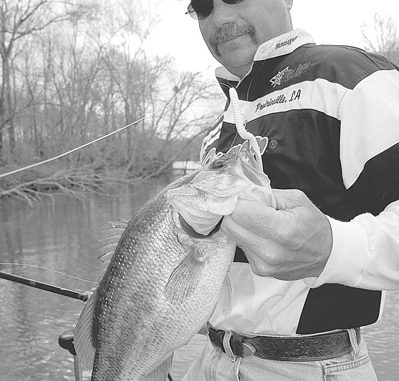
July can be a really good month for bass fishermen in North Carolina, but the one thing you need to understand is that you definitely can’t fish the same way the last of the month that you fished the first of the month. Even though July might seem like a month for a consistent summer pattern on most lakes, there’s a tremendous amount of change that goes on.
On most of our lakes in North Carolina, July will start with fish either on a postspawn pattern or in a summer pattern. On some of our lakes toward the Virginia border, like Buggs Island and Gaston, fish will be getting over the postspawn and really hungry, ganging up. It’s a great time to fish, because where you catch one, there might be 15 more right there. They fish like High Rock does from Memorial Day to Father’s Day — a great bite for fish just starting to feed up after recovering from the spawn.
But plenty of lakes will be ahead of schedule, with fish in a summer pattern, finishing up that big feed and moving out as the water warms. You can very easily start the month fishing in 10 feet of water and, depending where you are, finish it fishing 22 to 24 feet deep.
Fishing is usually good up in the river section of a lake in July. They’ll be biting up there, because the water will be a little cooler. It’s a great time to break out a small crankbait, or to fish a Brush Hog or a trick worm or to Texas-rig a worm.
If you fish anywhere else, I’ve found that you can pattern bass that have moved to a summer pattern two ways: where they are in a creek or on the main lake, and what kind of bottom structure or cover they’ll be on. I like to start fishing about halfway back in a creek and fish my way out to the main lake — because bass will be taking the same kind of route from those little corners and secondary points where they gang up to feed after they recover from the spawn. The kinds of places they’re going to be on are big, steep drops, and mostly they’ll be on areas with a hard bottom or with stumps — they won’t get on brushpiles really good until the fall.
When I think I’ve worked out where I’m going to find fish, I typically set my boat up over deeper water and cast toward the shallows. I don’t line up parallel with a drop and try to fish along it, because the fish won’t necessarily be right on the same spot. You might find bass up on the flat at the edge of the drop, or they’ll be off it just a little ways on the drop. If you fish parallel, you could very well run your bait right where you want it to, at just about the right depth, and have it pass them several feet away, too far for them to chase. By throwing in and working your bait back to deep water, you bring it right down the slope and you cover several different depth zones.
There is an interesting pattern that plays out on some lakes by the end of the month. Depending on the amount of rainfall a lake’s watershed gets, and how much current is being pulled, you may find bass moving up shallow a little, looking for water that’s got more dissolved oxygen. If there’s been a lot of rain and there’s a lot of current being pulled through the lake, they’re not as likely to move up. But they will move up, and sometimes you’ll catch ‘em around docks or little shallow places like you catch ‘em at the end of May. That pattern can come and go pretty quickly, however, because a good rainstorm can change things almost overnight.
It’s also worth remembering to have a topwater bait tied on, especially early in the morning. Because it’s been dark for eight of 10 hours overnight, the water is going to be at its coolest point around daylight, and fish are likely to move up and feed. That can be a good time to fish a Spook, a Skitterwalk, a Pop-R or a buzzbait. I can remember a few July tournaments on Buggs Island where guys wore them out with a buzzbait.
As far as lure colors are concerned, it’s tough to beat shad colors, because that’s what bass will be keying on. One other thing about fishing a crankbait is, in July, a rattling bait seems to catch a lot of fish.
Whatever you do, keep in mind that you’ve got to follow the bass this month as they move out with the warming water, and as they change the area of the lake where they live and the kind of places they live.




Be the first to comment